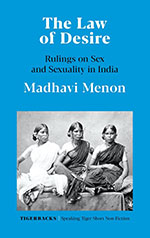Menon covers an array of issues revolving around the idea of ‘desire’ through the paradigms of sexuality(s), politics, culture, and so on. Looking at how Indian law shapes our understanding and limits of desire and how desire has had a similar relationship with the law, creating normative and descriptive imperatives, she backs up almost every claim she makes by factual data in case law, historical evidence, or academic works, over the course of six chapters.
Menon starts by questioning normative ideas assumed by the Indian state, as it prescribes/enforces laws to its population. She talks about the normalization of certain ideas which have been ingrained in the Indian society since precolonial to postcolonial times, as she attempts to challenge and question them. Menon speaks about two concepts which are at diametrically opposite ends as central and recurring themes of the book, ‘desire’ and ‘law’.

